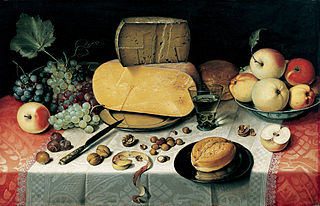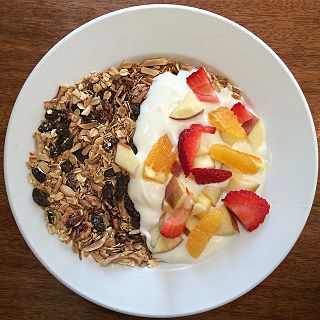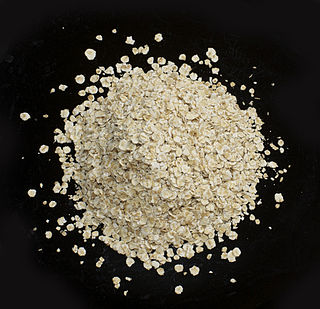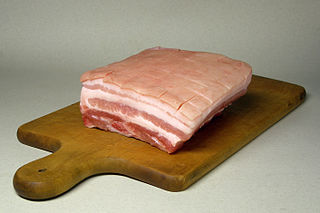 W
WBreakfast is the first meal of the day eaten after waking from the night's sleep, in the morning. The word in English refers to breaking the fasting period of the previous night. There is a strong likelihood for one or more "typical", or "traditional", breakfast menus to exist in most places, but their composition varies widely from place to place, and has varied over time, so that globally a very wide range of preparations and ingredients are now associated with breakfast.
 W
WThis is an index of breakfast-related articles. Breakfast is the first meal taken after rising from a night's sleep, most often eaten in the early morning before undertaking the day's work. Among English speakers, "breakfast" can be used to refer to this meal, or to a meal composed of traditional breakfast foods served at any time of day.
 W
WBrunch is a combination of breakfast and lunch and regularly has some form of alcoholic drink served with it. It is usually served between 9am and 1pm. The word is a portmanteau of breakfast and lunch. Brunch originated in England in the late 19th century and became popular in the United States in the 1930s.
 W
WCereal, formally termed breakfast cereal, is a traditional breakfast food made from processed cereal grains. It is traditionally eaten as part of breakfast, or a snack food, primarily in Western societies.
 W
WA champagne breakfast is a breakfast served with champagne or sparkling wine. It is a new concept in some countries and is not typical of the role of a breakfast.
 W
WDim sum is a large range of small Chinese dishes that are traditionally enjoyed in restaurants for breakfast and lunch. Most modern dim sum dishes originated in Guangzhou in southern China and are commonly associated with Cantonese cuisine, although dim sum dishes also exist in other Chinese cuisines. In the tenth century, when the city of Guangzhou (Canton) began to experience an increase in commercial travel, travellers concurrently began to frequent teahouses for small-portion meals with tea called yum cha, or "drink tea" meals. Yum cha includes two related concepts. The first is "yat jung leung gin" (一盅兩件), which translates literally as "one cup, two pieces". This refers to the custom of serving teahouse customers two pieces of delicately made food items, savory or sweet, to complement their tea. The second is dim sum (點心) and translates literally to "touching heart", the term used to designate the small food items that accompanied the tea drinking.
 W
WElevenses is a short break taken at around 11:00 am to consume a drink or snack. The names and details vary among countries.
 W
WAn English muffin is a small, round and flat yeast-leavened sourdough bread which is commonly sliced horizontally, toasted, and buttered. It is often part of breakfast in North America, Australia and New Zealand, frequently eaten with sweet or savory toppings such as fruit jam or honey, or eggs, sausage, bacon, or cheese. English muffins are an essential ingredient in Eggs Benedict and a variety of breakfast sandwiches derived from it, such as the McMuffin.
 W
WA full breakfast is a substantial cooked breakfast meal, often served in the United Kingdom and Ireland, that typically includes bacon, sausages, eggs, black pudding, baked beans, tomatoes, mushrooms, toast, and a beverage such as coffee or tea. It appears in different regional variants and is referred to by different names depending on the area. While it is colloquially known as a "fry up" in most areas of the UK and Ireland, it is usually referred to as a "full English", a "full Irish", "full Scottish", "full Welsh", "full Cornish", and "Ulster fry", in England, the Republic of Ireland, Scotland, Wales, Cornwall, and Northern Ireland, respectively.
 W
WGoetta is a meat-and-grain sausage or mush of German inspiration that is popular in Metro Cincinnati. It is primarily composed of ground meat, pin-head oats and spices. It was originally a dish meant to stretch out servings of meat over several meals to conserve money, and is a similar dish to scrapple and livermush, both also developed by German immigrants.
 W
WGranola is a breakfast food and snack food consisting of rolled oats, nuts, honey or other sweeteners such as brown sugar, and sometimes puffed rice, that is usually baked until it is crisp, toasted and golden brown. During the baking process, the mixture is stirred to maintain a loose breakfast cereal consistency. Dried fruit, such as raisins and dates, and confections such as chocolate are sometimes added. Granola is often eaten in combination with yogurt, honey, fresh fruit, milk or other forms of cereal. It also serves as a topping for various pastries, desserts or ice cream.
 W
WHalva refers to various local confection recipes. The name is used for referring to a huge variety of confections, with the most geographically common variety based on toasted semolina.
 W
WAn Israeli breakfast is a distinctive style of breakfast that originated on the Israeli collective farm called a kibbutz, and is now served at most hotels in Israel and many restaurants. It is usually served buffet style, and consists of fruits, vegetables, salads, breads, pastries, dairy foods, eggs and fish. Meat is never included.
 W
WA kipper is a whole herring, a small, oily fish, that has been split in a butterfly fashion from tail to head along the dorsal ridge, gutted, salted or pickled, and cold-smoked over smouldering wood chips.
 W
WMidnight breakfast is a generic term for a communal meal served at some American colleges and universities, often served during finals week. Menu items that are generally considered breakfast foods are served in the school's dining hall late at night as a study break before or during final exams, or as a traditional community-building event. Sometimes food is served by faculty and staff. Midnight breakfast is an occasional event and should not be confused with school dining facilities that operate 24 hours a day on a regular basis.
 W
WOatmeal refers to a preparation of oats that have been dehusked, steamed and flattened, or else a coarse flour made of hulled oat grains (groats) that have either been milled (ground) or steel-cut. Ground oats are also called "white oats". Steel-cut oats are known as "coarse oatmeal", "Irish oatmeal" or "pinhead oats". Rolled oats were traditionally thick "old-fashioned oats", but can be made thinner or smaller, and may be categorized as "quick" or "instant", depending on the cooking time, which is shortened by the size of the oats and precooking.
 W
WIn cuisine, an omelette or omelet is a dish made from beaten eggs, fried with butter or oil in a frying pan. It is quite common for the omelette to be folded around fillings such as chives, vegetables, mushrooms, meat, cheese, or some combination of the above. Whole eggs or egg whites are often beaten with a small amount of milk, cream, or water.
 W
WThe Oslo breakfast was a type of uncooked school meal developed in the 1920s and rolled out as a free universal provision for Oslo school children in 1932. It typically consisted of bread, cheese, milk, half an apple and half an orange.
 W
WA pancake is a flat cake, often thin and round, prepared from a starch-based batter that may contain eggs, milk and butter and cooked on a hot surface such as a griddle or frying pan, often frying with oil or butter. Archaeological evidence suggests that pancakes were probably the earliest and most widespread cereal food eaten in prehistoric societies.
 W
WA pancake breakfast is a public meal attached to many festivals, religious celebrations, and community events which involves volunteers cooking large quantities of pancakes and other hot breakfast foods for the general public, often for free or for a nominal charge if the event is a fundraiser.
 W
WPork rind is the culinary term for the skin of a pig. It can be used in many different ways.
 W
WRolled oats are a type of lightly processed whole-grain food. Traditionally, they are made from oat groats that have been dehusked and steamed, before being rolled into flat flakes under heavy rollers and then stabilized by being lightly toasted.
 W
WSecond breakfast is a meal eaten after breakfast, but before lunch. It is a traditional meal in Bavaria, Poland, Slovakia, Spain and Hungary. In Bavaria and Poland, special dishes are made exclusively to be eaten during second breakfast. In Vienna and most other parts of Austria the second breakfast is referred to as Jause. In other Spanish-speaking countries, almuerzo means lunch, but in Spain it is a second breakfast. It is typical to eat four to five meals a day in these locations.
 W
WShakshouka is a Maghrebi dish of eggs poached in a sauce of tomatoes, olive oil, peppers, onion and garlic, commonly spiced with cumin, paprika and cayenne pepper. According to Joan Nathan, shakshouka originated in Ottoman North Africa in the mid-16th century after tomatoes were introduced to the region by Hernan Cortés as part of the Columbian exchange.
 W
WSahūr or Suhūr, also called Sahari, Sahrī or Sehri is the meal consumed early in the morning by Muslims before fasting (sawm), before dawn during or outside the Islamic month of Ramadan. The meal is eaten before fajr prayer. Sahur is matched to iftar as the evening meal, during Ramadan, replacing the traditional three meals a day, although in some places dinner is also consumed after iftar later during the night.
 W
WA wedding breakfast is a feast given to the newlyweds and guests after the wedding, making it equivalent to a wedding reception that serves a meal. The phrase is still used in British English.
 W
WYum cha is the Cantonese tradition of brunch involving Chinese tea and dim sum. The practice is popular in Cantonese-speaking regions, including Guangdong province, Guangxi province, Hong Kong, and Macau. It is also carried out in other regions worldwide where there are overseas Cantonese communities. Yum cha generally involves small portions of steamed, pan-fried, or deep-fried dim sum dishes served in bamboo steamers, which are designed to be eaten communally and washed down with hot tea. People often go to yum cha in large groups for family gatherings and celebrations.